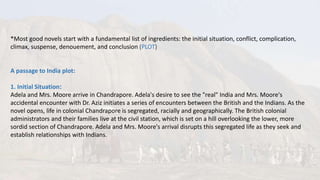Novel
- 1. A passage to India Plot Group members: Suhair Saleh Albalawi Asmaa Saleh Alissa
- 2. Introduction: E . M . Forster wrote A passage to India in 1924, the last completed novel that he published during his lifetime. The novel differs from Forster's other major works in its overt political content, as opposed to the lighter tone and more subdued political subtext contained in works such as Howards End and A Room with a View. The novel deals with the political occupation of India by the British, a colonial domination that ended after the publication of Forster's text and still during his lifetime.
- 3. *Most good novels start with a fundamental list of ingredients: the initial situation, conflict, complication, climax, suspense, denouement, and conclusion (PLOT) A passage to India plot: 1. Initial Situation: Adela and Mrs. Moore arrive in Chandrapore. Adela's desire to see the "real" India and Mrs. Moore's accidental encounter with Dr. Aziz initiates a series of encounters between the British and the Indians. As the novel opens, life in colonial Chandrapore is segregated, racially and geographically. The British colonial administrators and their families live at the civil station, which is set on a hill overlooking the lower, more sordid section of Chandrapore. Adela and Mrs. Moore's arrival disrupts this segregated life as they seek and establish relationships with Indians.
- 4. 2. Conflict: On an excursion to the Marabar Caves, Adela believes that she has been molested by Dr. Aziz. Dr. Aziz is charged and taken into custody. There's a lot of build-up to the conflict of the novel, with a number of failed social occasions where the English and the Indians have trouble connecting, including the Bridge Party and Fielding's tea party. The picnic at the Marabar Caves brings all of these tensions to a head. Significantly, what actually happens at the caves is left out of the narrative, leaving the novel with its own version of a literary cave. 3. Complication: Aziz's trial exacerbates relations between the British and the Indian communities in Chandrapore. Fielding breaks ranks with the British and sides with the Indians in Aziz's defense. By committing himself to Aziz's cause, Fielding exposes a rift within British society. Instead of proceeding directly to punishing a man whose guilt they assume, the British find themselves being challenged by the values that Fielding represents – civilized discourse, tolerance, and the rule of law. Fielding's actions also spur Adela to question her interpretation of events.
- 5. 4. Climax: At the trial, Adela withdraws her charge against Aziz. Chaos ensues. When Adela takes the stand, the novel stresses that she feels as though she were being led along the "paths of truth." At last, you might think, the truth. But the climax isn't the revelation of the truth of what happened in the cave. The novel just says that Adela remembers nothing. Which means no Aziz. Adela's withdrawal of her charge is the real climax of the story, sending the courtroom and the rest of Chandrapore into turmoil. 5. Suspense: Adela is ostracized by everyone in Chandrapore. The news of Mrs. Moore's death spreads even as Aziz, Fielding, and their supporters celebrate Aziz's release. Adela's retraction doesn't, however, solve all the issues raised by the trial. Her honesty doesn't make her a heroine; to everyone with the exception of Fielding at this point, Adela's retraction only shows that she is a silly girl who made a terrible mistake. Moreover, Aziz's victory doesn't solidify his friendship with Fielding, as it opens up a host of new issues surrounding his lawsuit against Adela for damages.
- 6. 6. Denouement: Fielding convinces Aziz not to sue Adela for damages. Fielding leaves for Britain as Aziz contemplates working in a Hindu state. The denouement is hardly satisfactory for any of the parties involved. Adela goes back to England, still single and without any real answers about what happened in the cave. Aziz decides not to sue Adela, but bitterly resents Fielding for persuading him not to. Fielding leaves for England before he can clear up the misunderstanding with Aziz. 7. Conclusion: A few years later at Mau, Aziz and Fielding reunite and mutually recognize the impossibility of continuing their friendship. In the last section of the novel, Aziz and Fielding reunite and finally clear up the misunderstanding about Fielding's relationship with Adela. While they are anxious for the whole Marabar Cave incident to be washed away from their lives forever, they come to recognize that as an Englishman and an Indian in British India, they cannot stay friends.
- 7. Finally, in this dramatic novel the author depicts sympathy and accurate realization a complex reaction of East before the British rule in India and reveals a struggle between traditions and mores which involved in the relationship.







